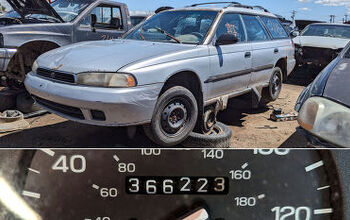Editorial: Grammar Patrol: How Shall We Denote Engine Output?
The Truth About Cars presents news and opinion in an informal, conversational manner. As the site’s freshly anointed copy editor, preserving this style without being too anal retentive is a real challenge. I keep telling myself not to adhere to the rules of formal writing (Strunk & White be damned). This is a new age. The old styles aren’t always appropriate for Web 2.x (and beyond). This internal struggle informs my desire to write the official TTAC style guide. I’m trying to reconcile our contributors’ literary voices with necessary structure and, this is the important bit, community consensus. I want to give TTAC a distinctive, consistent voice in the autoblogosphere, during a time of uncertainty and change. I need your help.
Let’s begin this journey with torque and horsepower; twist and ponies. While I don’t want to reduce TTAC writers’ freedom to describe a car’s thrust, something must be done about the use of engine-related statistics on this site.
Recently, TTAC contributor Jonny Lieberman co-opted Jeremy Clarkson’s use of the word “torques.” Our left coaster did it twice, clearly intending the term to replace “lb/ft” or “pound-feet of torque.” Not to mention, Farago’s recently abandoned, UK-centric “ft.-lbs.”
The newly christened nickname certainly sounds faddish. To some, it’s an overly familiar affectation. “The Porsche Carrera GT has 435 torques.” That said, plenty of pistonheads use “ponies” or “horses” in place of “horsepower.”
Be that as it may, Jonny’s assault on my anal retentive nature underscores the need to agree on a house style for the stat: a standard technical designation for an engine’s torque. So, what should it be: lb/ft or pound-feet or foot pounds or ft-lbs. or something else?
If only it were that easy…
Next, should we list the rpm at which maximum torque arrives? “The Porsche Carrera’s V10 delivers 435 ft lbs @ 5750 rpm” as opposed to “The Porsche Carrera’s V10 develops 435 torques?” [NB: don’t get me started on “develops,” “stumps up,” “generates,” and so forth.]
Keep in mind that TTAC reviewers butt up against an 800-word limit. Every word—and number—counts.
Just to make matters that much more complicated, what about Newton meters?
TTAC has a global audience, many of whom use the metric system. Should we offer both lb/ft (or whatever) and Newton meters? If we do use Newton meters, should we use the formal “Newton meters” or “N-m” or (and I’m kidding here) just use “newts?”
Horsepower is not as straightforward as it sounds. We can choose between HP and hp and a space between the number and numerical statistic, or not. “The Carrera GT’s engine is good for 605 hp” or “The Carrera GT’s engine is good for 605hp” or “The Carrera GT’s engine is good for 605 HP.”
Again, metric issues arise: kilowatts! Should we go there? If we offer newts, why not kwatts?
And if we do do that voodoo that kilowatts do, should it be “KW” or “kw,” space or no space? And if we offer an rpm arrival point for maximum torque, why not horsepower? For example, “The lightweight Porsche Carrera GT has tremendous torque (589.78 nm / 435 ft lbs @ 5750 rpm) and prodigious power (451.2 kw / 605 bhp @ 8000 rpm).” I’ve got a headache…
The alternatives don’t stop there. We could prevent an international incident with a hover hack: readers could mouse over the U.S. ratings (or not) to discover the equivalent metric amount. Or we could add a horsepower and torque box with the stars and stats and not worry about numbers in the actual review. And finally…
We could drop the whole thing. RF figures TTAC’s not Car and Driver. “We’re trying to convey the soul of a machine. We’re not under no obligation to provide ANY statistics.” Thanks for that, boss. But if we do offer engine output numbers—and you know we will—TTAC should do so with logic, clarity and complete consistency. Please, help me in this quest by taking this survey.
Early 30s California guy driving a 97 Infiniti I30. Past cars: 90 Cavalier, 82 Skylark, 78 Courier, 61 Beetle.
More by Jeff Puthuff
Latest Car Reviews
Read moreLatest Product Reviews
Read moreRecent Comments
- Lou_BC Nah. Tis but a scratch. It's not as if they canceled a pickup model or SUV. Does anyone really care about one less Chevy car?
- ToolGuy If by "sedan" we mean a long (enough) wheelbase, roomy first and second row, the right H point, prodigious torqueages, the correct balance of ride/handling for long-distance touring, large useable trunk, lush enveloping sound system, excellent seat comfort, thoughtful interior storage etc. etc. then yes we need 'more' sedans, not a lot more, just a few really nice ones.If by "sedan" we mean the twisted interpretation by the youts from ArtCenter who apparently want to sit on the pavement in a cramped F16 cockpit and punish any rear seat occupants, then no, we don't need that, very few people want that (outside of the 3 people who 'designed' it) which is why they didn't sell and got canceled.Refer to 2019 Avalon for a case study in how to kill a sedan by listening to the 'stylists' and prioritizing the wrong things.
- Lou_BC Just build 4 sizes of pickups. Anyone who doesn't want one can buy a pickup based SUV ;)
- Jor65756038 If GM doesn't sell a sedan, I'll buy elswhere. Not everybody likes SUV's or crossovers or is willing to buy one no matter what.
- ToolGuy One thing is for sure: Automakers have never gone wrong following the half-baked product planning advice of automotive journalists. LOL.I wonder: Does the executive team at GM get their financial information from the Manager of Product and Consumer Insights at AutoPacific? Or do they have another source? Hmm...


































Comments
Join the conversation
Most parts of this question are simpler to answer than presented, because many of the proposed options are flatly wrong and therefore don't warrant consideration. The English unit of torque is correctly abbreviated lb·ft , with a middle dot. It does not have a period, an en- or em-dash, a hyphen, a slash, a stroke, or anything other than a middle dot. And the unit order is pounds followed by feet; "foot-pound" is a colloquialism. There is an especially unpleasant part of hell reserved for writers so high on the fumes from their overinflated self-perception of cleverness that they afflict us with asinine little affectations like "torques", which is right down with calling snow "the white stuff". As has already been correctly pointed out, the correct abbreviation for Newton-metres is Nm, and for kilowatts is kW. Horsepower is a little trickier, because there are multiple horsepower rating systems in common use. If we disregard that snag, then we need only pick the least-obtrusive method of abbreviation, which is lowercase/no-space: 245hp .
I think you should just have a box at the bottom. Give us the choice to tick which system we'd like to see and save that to a cookie. That way we always (and only) see the system we understand. But as stated you are not Car and Driver so I won't fret about this too much... Google is but a click away to find the specs if we really want it.